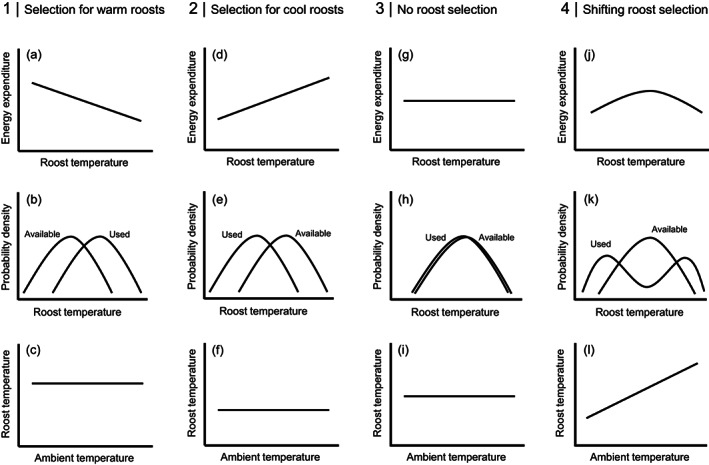FIGURE 2.

Four competing sets of predictions of microhabitat selection by a heterothermic bat. Each column represents one of four sets of predictions, and each row represents a statistical relationship consistent with the predictions. In column 1, energy expenditure over the course of a day is higher in cool microhabitats than in warm microhabitats (a). In response, bats select warm microhabitats to minimize energy expenditure during the day (b). In this scenario, there should be no directional relationship between ambient temperature and microhabitat temperature (i.e., bats always select warm microhabitats regardless of ambient temperature; (c)). In column 2, energy expenditure over the course of a day is higher in warm microhabitats than in cool microhabitats (d). In response, bats select cool microhabitats to minimize energy expenditure during the day (e). In this scenario, there should be no directional relationship between ambient temperature and microhabitat temperature (i.e., bats always select cool microhabitats regardless of ambient temperature; (f)). In column 3, energy expenditure over the course of a day is constant across microhabitats of all temperatures (because bats can adaptively use daily torpor so that temperatures within microhabitats have little influence on overall energy expenditure; (g)). Because energy expenditure is consistent across microhabitats of all temperatures, bats do not select microhabitats due to temperatures within microhabitats (h). In this scenario, there is no relationship between ambient temperature and temperature of used microhabitats (i.e., bats never select microhabitats due to temperatures within microhabitats, regardless of ambient temperature; (i)). In column 4, energy expenditure peaks at intermediate microhabitat temperatures at which bats use relatively little daily torpor, but the costs of maintaining homeothermy are relatively high (j). In response, bats select cool microhabitats on cool days and warm microhabitats on warm days (k) because daily torpor saves more energy in cool microhabitats than in warm microhabitats. In this scenario, the relationship between ambient temperature and microhabitat temperature should be positive (i.e., bats select warmer microhabitats on warmer days; (l))
